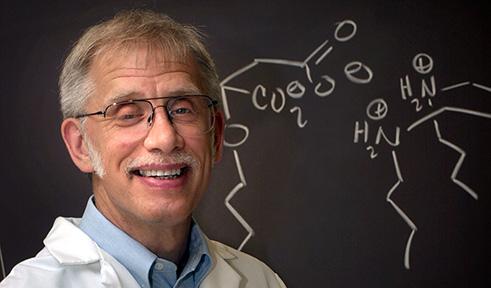Jared Butcher

Education
Ph.D., University of Tennessee
Research
- Metals and Micelles, Lasers and Robots,
- Polymers and Analyses
Metals and Micelles - Templates for reactions. The primary focus of research in Butcher's group has been, and remains, the construction of exotic macrocycles: knots (a single molecule looped around and tied in a knot), catenanes (two or more molecules linked like links in a chain), and rotaxanes (a ring stuck on a chain like a rotating tire on an axle). Based on an appreciation of geometry and geodesic math, these syntheses involve the precise alignment of vital components, either by using a metal to hold them or a micelle to contain them. Unnatural by nature and symmetrical in structure, they tend to make us wonder: "Why undertake the synthesis of a molecule nature neglected?" There are two reasons, really: The first one is beauty. The second is a hope that the use is simply unsuspected. Decide for yourself if these are worthwhile: (1) Synthesis of a knot as an object of art and the starting point for making enzyme mimics. (2) The sepak raga ball, the most complex of all catenanes, which can rearrange to fit any substrate. (3) Braided polymers, molecules woven together for no published reason whatever.
Lasers and Robots - Tools for construction. A significant bias in Butcher's group is that computers should make pretty molecules as well as they make pretty pictures. This leads to the conviction that automation of the monotonous and dull was the reason for going to school. Laser synthesis is fascinating, but doing it is time-consuming. An excimer laser produces an intense burst of photons that can be used to excite a single molecule multiple times, or to excite several molecules in a single aggregate at one time. The chemistry this makes possible is awesome. Even ordinary reactions done under computer control are unexpectedly interesting. Automation is a revolution that isn't over. The tools are available to make the molecules, leaving us with time to make up our minds about what molecules to make.
Polymers and Analyses - Environmental action. A chance discovery and a little imagination have combined in Butcher's group to produce a fascination with ordinary materials of a mundane description: plastic, coal and "trash". The repetitious and exhaustive use of these materials is a worthwhile goal, and the metals, micelles, lasers, and robots mentioned above provide the means, so why not do it? Work is in progress in Butcher's research group to develop catalysts for plastic cracking and to discover the mechanism by which they function. Every existing analytical tool is applied to these problems, and when the need arises, as it often does, new analytical procedures are invented. It's organic chemistry as usual: Spanning the gambit from "trash" to "treasure."
Selected Publications
Butcher, J.A., Jr. Method of Cracking Polymeric Materials Catalyzed by Copper. U.S. Patent 5,728,909, March 17, 1998; U.S. Paten 5,315,055, May 24, 1994.
Butcher, J.A., Jr.; Kidwell, H. Method for Depolymerization of Rubber. U.S. Patent 5,438,078, August 1, 1995.
Tandler, P.J.; Butcher, J.A., Jr.; Tao H.; Harrington, P. B. Analysis of Plastic Recycling Products by Expert Systems. Anal. Chim. Acta. 1995, 312, 231-244.
Ferguson, M.D.; Butcher, J.A., Jr. Alkali Metal Ion Mediated Cyclization of 4,4'-(3,6-Dioxaocta-1,8-Diyloxy)-Bis(Benzophenone). Tetrahedron Lett. 1993, 24, 3719-3722.
Gilliatt, V.J.; Sultany, C.M.; Butcher, J. A., Jr. Synthesis of the First Rotaxane Containing a Paracyclophane Ring. Tetrahedron Lett. 1992, 33, 6255-6258.